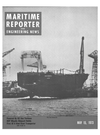
Page 25: of Maritime Reporter Magazine (May 15, 1973)
Read this page in Pdf, Flash or Html5 edition of May 15, 1973 Maritime Reporter Magazine
Pacific NW Section Discusses
Shipboard Electrical Systems
Taking part in the meeting, left to right: Jock Keene, discusser; William R. Lapper, author of the paper; Lewis
Reinders, discusser, and Robert Cullen, charman, British
Columbia Area, Pacific Northwest Section of SNAME.
An especially deep and thorough coverage of the subject "Shipboard Electrical System
Design" was presented on March 29 to mem- bers and guests of the Pacific Northwest Sec- tion of The Society of Naval Architects and
Marine Engineers in Vancouver, British Co- lumbia, by William R. Lapper, W.R. Lapper & Associates.
The author commenced by stressing that proper attention must be paid to electrical and electronic systems in the design stage. Of prime importance is the integration of the gen- eration, distribution and utilization systems, and this is only possible by viewing the whole electrical and electronic picture while assessing the actual operating conditions.
Mr. Lapper then presented his format for listing all electrical requirements. The factors that emerge from his analysis are the estimated electrical load in kilowatts under varying op- erational conditions, as well as horsepower ratings of the larger electric motors.
In 1963, the author obtained approval from the Canadian Steamship Inspection Services for the feedback of electrical power fr"om the emergency generator to the main switchboard, providing certain conditions were met. The first of these conditions was that the feedback of power would be limited to the capability of the emergency generator set and secondly, feedback of power would be interrupted in the event of the start-up of any of the emergency pumps normally powered from the emergency switchboard. These requirements were met by introducing two additional circuit breakers, labeled by the author as a "Tie-breaker" and a "Feedback-breaker," with suitable interlocks so that when one was closed the other would open.
In 1967, Mr. Lapper convinced the Canadian
Steamship Inspection Service of the advantages of eliminating a central bank of transformers and instead, providing a series of small three- phase transformers, each mounted in its own sub-distribution panel, with a fixed number of double-pole, molded case, air circuit breakers.
Two of the several advantages of this system are minimum of disruption should one trans- former burn out, and reduction in feeder cable size due to the kVA demand being supplied at 440 volts.
The author feels shipyard personnel must appreciate the importance of integrating the electrical and electronic shipboard systems at the design stage in order that equipment sup- pliers may be able to bid on the most economi- cal basis to provide a satisfactory solution to the problems. He also hopes that suppliers accept suggestions for modification and im- provement which will result in more compact and better integrated installations.
Discussers were Jack Keene, Electrical In- spector, Department of Transport, and Lewis
Reinders, Lewis & Associates Engineering,
Ltd., firm of consulting engineers.
REPAIR at the CROSSROADS
Ideally Located for Speed, Economy and Convenience
A Complete American SHIP REPAIR SERVICE • 1000 ft. concrete outfitting pier • 691' reinforced concrete graving dock • Four mobile cranes • 2000 ton steel floating drydock • Complete machine—pattern- boiler plate—electrical—fabricating shops • Foundry • Design division • Ideally located for voyage or annual repair enroute
Plus—all the modern port facilities of San Juan, Puerto Rico.
TANKER WORK A SPECIALTY ^Pm^ipto HM©©
DRYDOCK & MARINE TERMINALS, INC.
San Juan, Puerto Rico 00903
P.O. Box 2209 • Telephone 723-6010 • 723-0769 • Cable address "Drydock"
Uobody I/"
SALT in ^tesh water! Especially GPM!
Which is why we detect & monitor it better than anyone else!
GPM's unique auto matic temperature compensated mod- ular SALINITY
SYSTEMS are the only systems that correct rapidly and precisely for abrupt changes in water temperature. In use with the U.S. Navy in nuclear submarines and other combat vessels.
We would appreciate an opportunity to discuss your requirements for: ^ • Salinity Indicating Systems • Power Panels • Transistorized Communications
Centers • Automatic Battery Chargers • Oil-in-Water Detectors . A|arm & Monitoring Pane|s
Our products are tailored to YOUR REQUIREMENTS for maximum performance.
Write, wire or phone
GALBRAITH-PILOT MARINE CORPORATION 166.National Road • Edison, New Jersey 08817 Telephone: (201) 287-281 0 TWX: 710-998-0560
May 15, 1973 27

 24
24

 26
26
